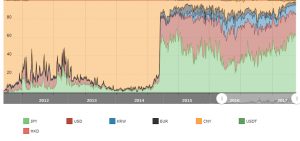Latest news about Bitcoin and all cryptocurrencies. Your daily crypto news habit.

CNY to bitcoin trading now accounts for approximately only 1% of all bitcoin trade occurring on exchanges, according to cryptocompare data. The Chinese cryptocurrency crackdown has drastically altered the global composition of bitcoin markets. 60% of bitcoin trading currently occurs through Japanese markets, with the U.S. and South Korean markets also comprising a significant share of the global bitcoin trade.
Also Read: Preparing for the Bitcoin Hard Forks: A Step-By-Step Walk-through
Japan Now Exerts Dominance Within the Bitcoin Markets
Last week, news.Bitcoin.com published a story that explained Japanese bitcoin trading comprises approximately 60% of all volume. Japanese trading volume spiked last year, following Japan’s passing of legislation recognizing bitcoin as a legitimate means of payment.
Approximately 80% of JPY/BTC trade during the last 24 hours took place on Bitflyer and Bitflyerfx. Coincheck is currently the second largest Japanese exchange, accounting for approximately 15% of trading. The third largest exchange, Zaif, comprises 4% of trading volume. As such, Japan’s bitcoin market is among the most centralized, with approximately 99% of BTC/JPY trading volume occurring on just three exchanges.
USD Comprises the Second Largest Bitcoin Market, Accounting for 25% of All Trading
The share of global bitcoin trading done in USD has fluctuated greatly over the years. During bitcoin’s infancy, the overwhelming majority of bitcoin trading was conducted in USD. Following China’s dramatic entrance into bitcoin markets at the end of 2013, the share of total trade conducted in US dollars fell to less than 10%. Since China’s crackdown on margin and cryptocurrency trading, dollar trade has risen to approximately one-quarter of all trade.
Bitfinex is the dominant exchange for USD trading, accounting for approximately 40% of the last 24h trading volume. Bitstamp is second, with 13%, followed by Gdax – 12%, Gemini – 7.5%, and Poloniex – 7%. The USD bitcoin markets are among the most decentralized, with approximately 90% of volume being shared across the top seven exchanges.
South Korea Has Emerged as a Significant Player in the Bitcoin Markets
Currently, South Korean volume accounts for roughly 9% of all bitcoin trading. The majority of South Korean trading occurs on Bithumb, which currently comprises 65% of 24-hour trade volume. Coinone and Korbit each account for approximately 17% of trade respectively. Bitcoin to Euro trading is the fourth most dominant sector of the bitcoin markets, comprising 3.3% of 24-hour trade volume.
Over the last twelve months, Chinese exchanges have gone from hosting over 90% of all bitcoin trade, to just 1% of the global volume. China is now the fifth largest market for exchange-based trading, with approximately 4600 bitcoins being traded for CNY on exchanges.
The Diminishing Presence of Chinese Bitcoin Exchanges
In January, it was announced that the People’s Bank of China would be monitoring the operations of the country’s major bitcoin exchanges. Soon thereafter, the PBOC placed restrictions on the amount of leverage offered for margin trading by Chinese exchanges, amidst accusations that high leverage trading may have been used to manipulate prices.
The ban on margin trading inspired speculation that bitcoin would not be able to sustain the bull trend leading into 2017 that had seen bitcoin break above $1000 USD for the first time since 2014. Ultimately, the clamp-down on Chinese margin trading appeared to have been interpreted as a positive indication of the cryptocurrency’s maturation, as prices continued establishing all-time highs despite the major Chinese bitcoin exchanges accounting for approximately 10% of total overall market share respectively.
Speculations of bitcoin’s inability to support record prices without a dominant Chinese presence again circulated in the run-up to most of China’s cryptocurrency exchanges ceasing operations by the start of October. With bitcoin setting new all-time price highs, it would appear that the bitcoin markets have emerged unscathed by the closure of most Chinese cryptocurrency exchanges.
What are your thoughts on the changing dynamics of the bitcoin markets? Let us know in the comments section below!
Images courtesy of Shutterstock, Cryptocompare
At News.Bitcoin.com all comments containing links are automatically held up for moderation in the Disqus system. That means an editor has to take a look at the comment to approve it. This is due to the many, repetitive, spam and scam links people post under our articles. We do not censor any comment content based on politics or personal opinions. So, please be patient. Your comment will be published.
The post JPY, USD, and KRW Accounts for Over 90% of Bitcoin Traded on Exchanges appeared first on Bitcoin News.
Disclaimer
The views and opinions expressed in this article are solely those of the authors and do not reflect the views of Bitcoin Insider. Every investment and trading move involves risk - this is especially true for cryptocurrencies given their volatility. We strongly advise our readers to conduct their own research when making a decision.



